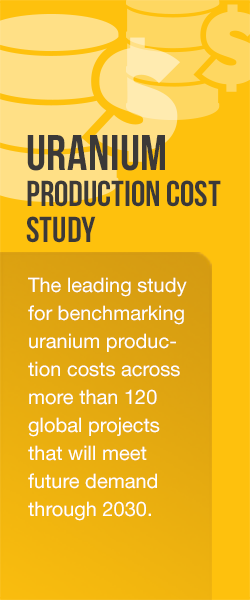The Credit Crisis and Nuclear Markets
The news that is currently gripping the United States and the world at large is the credit crisis in the U.S. Financial institutions have failed in the U.S. and Europe, and there is concern that more will fail. Things will likely get worse before getting better now that the U.S. House of Representatives voted 228-205 against the financial bailout plan. However, even if this legislation were passed and signed into law, it is not seen as a panacea for the crisis, the effects of which will likely be felt for some time. Pretty much all parts of the world economy have been or will be impacted by it, even the uranium market and nuclear power. Below we look at both the near-term and the long-term implications for the nuclear industry.
Recently, the uranium market has experienced a great amount of activity as sellers have adopted a more aggressive posture to the market. These sellers have included hedge funds and companies owned by funds or financial interests, and companies facing cash flow issues. One of the major changes in the spot uranium market over the past several years has been a greater involvement of hedge funds and other financial entities in the market. This makes the market more subject to the vicissitudes of the financial sector – hedge funds that are losing money in one area might have to sell uranium holdings for cash flow or to shore up their returns. In this respect, recent financially-motivated sales in the spot market may not have much to do with underlying uranium market fundamentals, but are more a function of general financial conditions.
The credit crisis has also affected activity in the uranium futures market. Over 5,000 contracts (equivalent to 1.25 million pounds U3O8) were traded last week for reasons that appear largely to be directly or indirectly attributable to the crisis. As we have previously noted, OTC activity that takes place is more likely to be cleared on the futures market to the extent that the credit crisis raises the potential for counterparty risk. Also, to the extent that the credit crisis has caused the spot market price to drop, profit-taking opportunities are created on the futures market, which encourages parties to close their positions.
The credit crisis has longer-term effects as well, as it certainly does not bode well for the future of nuclear power. Nuclear power plants are extremely capital intensive and thus require a great deal of financing, which will now be even more expensive and difficult to obtain. The other aspect of the crisis is that economic growth will likely be much slower in the future, and thus there will be less need for new electricity generating capacity, including that based on nuclear power. A saving grace for nuclear power might be if countries take steps to ensure financing for new plants for infrastructure/environmental reasons, but even if this happens, it is likely that less nuclear power will be needed.
While it may seem like slower requirements growth will result in lower uranium prices in the future, this isn’t necessarily the case. Similar to financing new nuclear power plants, it will be more difficult and more expensive to finance new mines, if they are financed at all. Uranium mining costs, as is the case with all mining costs, have greatly exceeded the general inflation rate even before the recent crisis, and this relationship will likely be maintained or exacerbated in the aftermath of the credit crisis.
The rate of uranium production expansion will be cut back due to both the recent fall in price and higher production costs. Because of this, many prospective projects which were questionable at recent price levels are even more problematic now. Further, the dimmer prospect for a nuclear renaissance in the wake of the credit crisis makes it that much less likely that investments in uranium production infrastructure will be made. As we have been saying for a while, a major factor in price formation will be how quickly uranium production expands relative to requirements. Here, there is the question of whether expansion in uranium production or expansion of nuclear power will suffer the most with respect to the credit crisis. However, even if production expansion keeps pace with nuclear power growth, the expansion that does occur will likely be at higher costs, and this will directly impact price.
Finally, the credit crisis reminds us of the very real possibility that markets can fail. We have discussed the concept of market failure as it pertains to the uranium market a number of times in this publication. It is revealing, if certainly not heartening, to see a market failure scenario being played out on such a grand scale, with the government again right in the middle of things.


